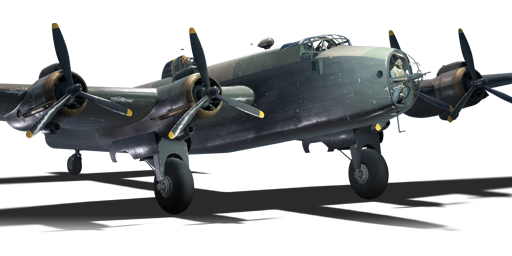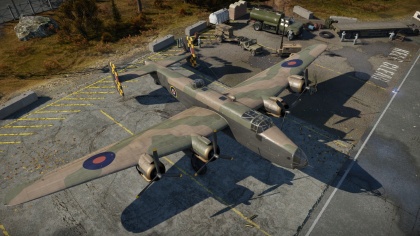Halifax B Mk IIIa
Contents
Description
The Halifax B Mk IIIa is a rank British bomber
with a battle rating of (AB), (RB), and (SB). It was introduced in Update 1.59 "Flaming Arrows".
The Halifax is an interesting member of the British bomber line. It is the first true British heavy bomber, a big change from its predecessors, which are all either flying boats, medium, or light bombers. With the transition to heavy bombers, comes a change in tactics. The Halifax will outclass almost every rank 2 and 3 bombers in terms of payload. It will also generally beat every same battle-rated bomber in the payload department as well. However, being a heavy bomber has its drawbacks. Compared to nearly all previous British bombers, this one is slower and has a noticeably slow climb rate. While the payload upgrade is nice, the Halifax is not very durable. Worse, the Halifax lacks effective defensive weapons, a flaw of nearly all British bombers. The main priority, as a result, should be targeting bases, and avoiding opposing pilots as much as possible. Use high altitude and less direct travel routes to get to your targets. If you are engaged, your defensive guns can save you, but they are not very reliable. In addition, you have no ventral turret, leaving a massive defensive gap. directly under the aircraft. You also only have one singular machine gun able to cover the fore-lower approach to your aircraft, and little in the way of armour plating for the pilot other than a steel bulkhead that won't protect against cannon shells or rifle caliber bullets well. However, if you can keep safe and deliver your payload, you will find this to be a very effective bomber.
General info
Flight performance
Describe how the aircraft behaves in the air. Speed, manoeuvrability, acceleration and allowable loads - these are the most important characteristics of the vehicle.
| Characteristics | |||||||
|---|---|---|---|---|---|---|---|
| Stock | |||||||
| Max Speed (km/h at 4,115 m) |
Max altitude (meters) |
Turn time (seconds) |
Rate of climb (meters/second) |
Take-off run (meters) | |||
| AB | RB | AB | RB | AB | RB | ||
| 435 | 419 | 35.0 | 35.8 | 3.8 | 3.8 | 750 | |
| Upgraded | |||||||
| Max Speed (km/h at 4,115 m) |
Max altitude (meters) |
Turn time (seconds) |
Rate of climb (meters/second) |
Take-off run (meters) | |||
| AB | RB | AB | RB | AB | RB | ||
| 477 | 454 | 33.2 | 34.0 | 9.9 | 6.5 | 750 | |
Details
| Features | ||||
|---|---|---|---|---|
| Combat flaps | Take-off flaps | Landing flaps | Air brakes | Arrestor gear |
| ✓ | ✓ | ✓ | X | X |
| Limits | ||||
|---|---|---|---|---|
| Wing-break speed (km/h) |
Gear limit (km/h) |
Combat flaps (km/h) |
Max Static G | |
| + | - | |||
| 520 | ~4 | ~3 | ||
| Optimal velocities | |||
|---|---|---|---|
| Ailerons (km/h) |
Rudder (km/h) |
Elevators (km/h) |
Radiator (km/h) |
| < 350 | < 370 | < 350 | > 280 |
| Compressor (RB/SB) | ||
|---|---|---|
| Setting 1 | ||
| Optimal altitude | 100% Engine power | WEP Engine power |
| 1,447 m | 1,400 hp | 1,596 hp |
| Setting 2 | ||
| Optimal altitude | 100% Engine power | WEP Engine power |
| 4,115 m | 1,300 hp | 1,482 hp |
Survivability and armour
- 6.35 mm steel in front and floor of cockpit
- 8 mm steel behind pilot and in rear fuselage bulkhead
Armaments
Suspended armament
The Halifax B Mk IIIa can be outfitted with the following ordnance:
- 15 x 250 lb G.P. 250 lb Mk.IV bombs (3,750 lb total)
- 15 x 500 lb G.P. 500 lb Mk.IV bombs (7,500 lb total)
- 9 x 1,000 lb M.C. 1,000 lb Mk.I bombs + 6 x 500 lb G.P. 500 lb Mk.IV bombs (12,000 lb total)
Defensive armament
The Halifax B Mk IIIa is defended by:
- 1 x 7.7 mm Vickers K machine gun, nose turret (1,000 rpg)
- 4 x 7.7 mm Browning .303 machine guns, dorsal turret (600 rpg = 2,400 total)
- 4 x 7.7 mm Browning .303 machine guns, tail turret (1,700 rpg = 6,800 total)
Usage in battles
The Halifax Mark IIIa is the first true "heavy" bomber that an allied player will unlock. It has engines that do well at higher altitudes- 4500 metres- and it has a large payload of nearly 12000lbs of bombs, going by weight. This is sufficient so that one Halifax can, on their own, annihiliate all three minibases and take a small chunk out of the enemy airfield, and otherwise, it can take a sizeable chunk out of the airfield- around three quarters of the base's total HP. Two halifaxes can annihilate all the bases and the airfield together.
Manual Engine Control
| MEC elements | ||||||
|---|---|---|---|---|---|---|
| Mixer | Pitch | Radiator | Supercharger | Turbocharger | ||
| Oil | Water | Type | ||||
| Not controllable | Controllable Not auto controlled |
Not controllable Not auto controlled |
Controllable Not auto controlled |
Combined | Controllable 2 gears |
Not controllable |
Modules
| Tier | Flight performance | Survivability | Weaponry | ||
|---|---|---|---|---|---|
| I | Fuselage repair | Radiator | SUBC mk.I | ||
| II | Compressor | Airframe | Turret 7 mm | ||
| III | Wings repair | Engine | MBC mk.III | ||
| IV | Engine injection | Cover | New 7 mm MGs (turret) | ||
Pros and cons
Pros:
- Versatile - It is capable of flying low-altitude runs for minibases, or high-altitude bomb runs.
- Can carry an overwhelming 12,000 lb of bombs, giving it the heaviest payload at rank II-III, and outclasses many rank IV bombers
- (Realistic Battles) Full payload lets it take out all three bases in one pass with four 1,000 lb bombs to spare (first base : 6 x 500 lb + 1 x 1,000 lb / second base : 2 x 1,000 lb / third base : 2 x 1,000 lb / airfield : 4 x 1,000 lb.
- Full payload can also take out 3/4 of an Airfield's HP in the BR 3.7-4.7 range
- Fast and fairly manoeuvrable for a heavy bomber, with flaps that do not rip easily
- Performance is almost unaffected by payload options due to internal payload carriage that doesn't create drag
- Fantastic climb rate with WEP; can easily reach 6,000 m with full payload just by side climbing (which is heavily advised to minimize interception)
- Can fly with two engines if needed - or even one, if trying to land.
- Matchmaking typically places the bomber against planes less deadly than the ones later British bombers face
- Defensive armament is decent for a British bomber. You can put eight guns rearward to defend against enemy targets.
- Tail gunner has a lot of ammunition (4 x 7.7 mm machine guns with 1,700 rounds per gun). In addition, he can fire almost directly down, directly under the turret, so unless an enemy goes directly under your airframe, you should have time to react and fire a few bursts.
- Impressive aircraft overall in terms of bombers, arguably outclassing the succeeding Stirling in the next rank and can be a game changer for the team if left unchecked
- Economical plane to fly as an easy Silver Lion
 and Research Points
and Research Points  grinder
grinder - The aircraft, if in the hands of a capable pilot, can fly with horrific damage to control surfaces and engines. One of the contributors has personally flown a halifax with no tail control, an aileron critically damaged and two engines dead (outer left and right).
Cons:
- Large target
- Priority target (in Arcade battles) that smart players will aim for first
- Stock payload is useless for base bombing
- Nose is defended by a single 7.7 mm gun and the belly has no machine gun coverage, leaving them very vulnerable for enemy attacks.
- 7.7 mm turrets are overall not very effective
- Only one pilot, no copilot like other bombers. In addition, the pilot is not armoured, and is vulnerable to a head-on, since the only frontal defense is a single 7.7mm gun.
- WEP causes overheating unless manual engine control is used to force radiators open
- Fragile structure compared to most competing bombers and previous British bombers
- Severe lack of armour for crew leaves them vulnerable
History
Describe the history of the creation and combat usage of the aircraft in more detail than in the introduction. If the historical reference turns out to be too long, take it to a separate article, taking a link to the article about the vehicle and adding a block "/History" (example: https://wiki.warthunder.com/(Vehicle-name)/History) and add a link to it here using the main template. Be sure to reference text and sources by using <ref></ref>, as well as adding them at the end of the article with <references />. This section may also include the vehicle's dev blog entry (if applicable) and the in-game encyclopedia description (under === In-game description ===, also if applicable).
Media
Excellent additions to the article would be video guides, screenshots from the game, and photos.
See also
Links to the articles on the War Thunder Wiki that you think will be useful for the reader, for example:
- reference to the series of the aircraft;
- links to approximate analogues of other nations and research trees.
External links
Paste links to sources and external resources, such as:
- topic on the official game forum;
- encyclopedia page on the aircraft;
- other literature.
| Britain bombers | |
|---|---|
| Torpedo | Swordfish Mk I · Swordfish Mk II · ▄Avenger Mk II |
| Dive | V-156-B1 |
| Hydroplanes | ▄Catalina Mk IIIa · Sunderland Mk IIIa · Sunderland Mk V |
| Light | Blenheim Mk IV · Beaufort Mk VIII · ▄Hudson Mk V · Brigand B 1 |
| Based on A20 | ▄Havoc Mk I · ▄Boston Mk I · ▄DB-7 |
| Hampden | Hampden Mk I · Hampden TB Mk I |
| Wellington | Wellington Mk Ic · Wellington Mk Ic/L · Wellington Mk III · Wellington Mk X |
| Halifax | Halifax B Mk IIIa |
| Stirling | Stirling B Mk I · Stirling B Mk III |
| Lancaster | Lancaster B Mk I · Lancaster B Mk III |
| Lincoln | Lincoln B Mk II |
| Shackleton | Shackleton MR.Mk.2 |






